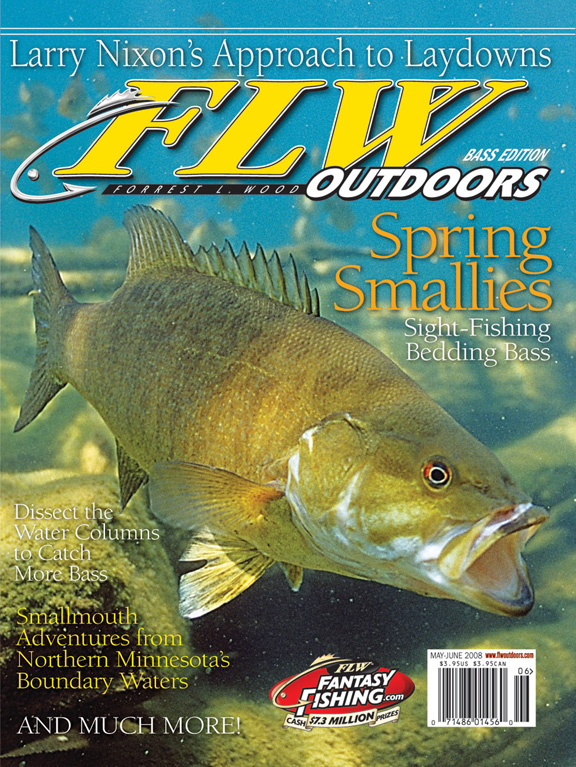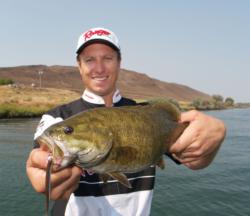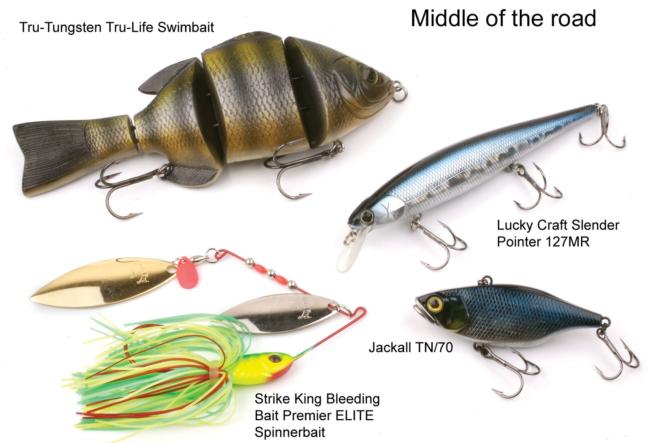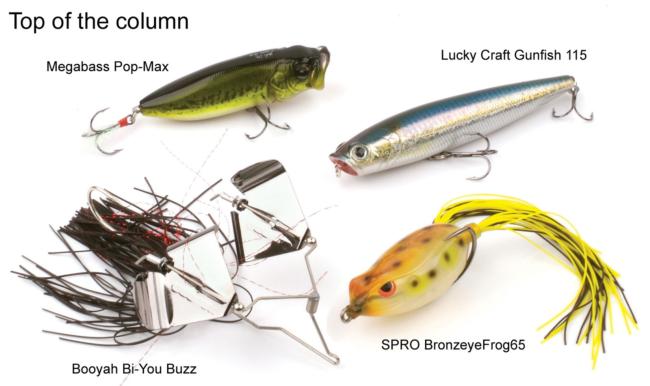Bass above and below
Work the water column for bigger bags

On its first attempt to eat my Heddon Zara Spook, the bass popped the lure out of the water with a telltale “sploosh.” It took the hooks on the second attempt, though, and a quick tussle brought it to the boat. Although only a small keeper, the bass was a welcomed sight considering the tough fishing we’d had that day last fall, fishing shallow grass lines on Kentucky Lake. It also gave a good clue as to where to go back with a spinnerbait and Texas rig to fish below the surface. The fish bit over a point outside a small cut in a large bay, and we managed a couple more fish with a spinnerbait there before heading on that day.
It was almost second nature to go back and re-cover the area with a spinnerbait and Texas rig after getting bit on a topwater, and it’s a tactic most every angler has used at some point, whether planned that way or subconsciously. That’s because by fishing at different depths in the water column, it quickly becomes possible to go from catching a couple of fish to a limit of fish. And by understanding what factors are likely to move fish throughout the water column, anglers can better learn to work different depth zones to be effective catching bass above and below.
Fish finders
National Guard pro Brent Ehrler of Redlands, Calif., approaches every tournament by fishing throughout the water column. He usually begins at the top because his favorite fishing is when he is on a topwater or jerkbait bite.
“What I’ll typically do is fish topwater first and try to locate the schools,” Ehrler said. “Typically what has happened, the way I’ve found them, is not watching for the boils but working the bait and waiting for one to hit. And a lot of times you get a wolf pack coming up.”
The wolf pack may be a result of the school being triggered to bite by one fish hitting Ehrler’s topwater lure. But even when a feeding frenzy of schooling bass doesn’t ensue, Ehrler still has the location of the fish somewhat fixed.
Thus is the advantage of a topwater, or any reaction bait, to cover a lot of ground quickly in order to locate fish. Sometimes the pattern even holds up throughout a tournament.
“Once I’ve located them, I’ve had it where I’ll go back and two days in a row they’ll hit a topwater and one day they won’t, and that’s when I pull out the jerkbait,” Ehrler said. “I don’t know what it is, if they just get conditioned to come up and hit the topwater, but then they just won’t.”
 At a recent bass tournament out West, Ehrler had just such a thing happen. He had singled out a half-mile stretch of water where fish were coming up and thrashing a Lucky Craft Gunfish 115. For two days, Ehrler worked the stretch and had good success. But on the third day, the clock read 1 p.m., and he had no fish. That’s when he changed to the Lucky Craft Staysee jerkbait, and his luck changed along with it.
At a recent bass tournament out West, Ehrler had just such a thing happen. He had singled out a half-mile stretch of water where fish were coming up and thrashing a Lucky Craft Gunfish 115. For two days, Ehrler worked the stretch and had good success. But on the third day, the clock read 1 p.m., and he had no fish. That’s when he changed to the Lucky Craft Staysee jerkbait, and his luck changed along with it.
“I kid you not, it was stupid,” Ehrler said. “I had my limit in just 45 minutes.”
The Staysee dives about 6 feet, and Ehrler relies on it in clear water typical to fisheries he frequents out West. It offered fish a deeper presentation and began a transition down through the water column, which caught fish that weren’t willing to commit to the topwater.
The jerkbait can also serve the same school-finding purpose as a topwater because it can also be worked quickly to cover a lot of water, and to target fish in open water, around shallow cover or relating to structure – the latter perhaps being the best target when working schools of fish within the water column.
“I would much rather find fish on structure, on something that gives me more confidence that they’ll be there when I come back,” Ehrler said. “Open-water fish tend to roam, and a lot of times you have to look at an area, a big bay, a cove or back of a creek (when targeting open-water fish). If it’s a flat and there’s open water where they can move out there, then the fish are gone if the wind blows and the bait moves.”
By working near cover or structure, when Ehrler finds a fish, it is not as likely to be a fluke cruiser that happened to spot his bait as it is a part of a local school. And once a school is located, the progression down the water column can continue.
When Ehrler made the switch from topwater to jerkbait, he did it because the fish “told” him they were ready for a change. They quit biting. From experience, Ehrler knew to follow them down through the water column. But there are other indicators that may tell an angler a change is in order. If he “listens” to what the fish say, he may go from catching no fish to grinding out a limit of fish.
“Typically what happens is you’ll see them come up and follow the topwater,” Ehrler said. “Then that’s a good indication when you can throw the jerkbait. And then you’ll get them to come up and follow the jerkbait; it’s just like they get conditioned. If that’s the case, then I’ll just pull out the worm or the jig.”
Follows without strikes may indicate the fish are switching to a less active time of day, when they don’t want to chase. Or perhaps they have grown weary of the lure and fishing pressure. A jig or worm on bottom can be the best answer. Wal-Mart FLW Tour events see large fields often fishing in small areas. Pros know when the fish get pressured, reaction bites often give way to slow presentations on bottom, where a majority of the fish are often caught.
“The fishing pressure will affect the water column the fish use more than the most severe cold front,” said Wal-Mart FLW Tour pro Randy Blaukat of Jasper, Mo. “In order to catch fish every day of the tournament you have got to be prepared to fish on the bottom. Unless you have some type of way to catch those fish when they’re on the bottom, you are going to get burned.”
For Ehrler, fishing bottom usually means making the switch to a drop-shot with a hand-poured worm or a Picasso shaky-head jig. But for Blaukat, who quite possibly was already fishing the bottom, it would mean modifying a bottom presentation to be fished deeper or slower. This is something the pro did at the 2008 Wal-Mart FLW Series BP Eastern Division event on Lake Okeechobee. During practice, many anglers, Blaukat included, were catching fish on shallow crankbait patterns in the rim canal in 2 feet of water. But as practice wore on and gave way to the tournament, many of those same anglers switched to shaky heads in deeper water.
“They were not using any middepth and upper water columns at all,” Blaukat said. “If there was not pressure, they would have used all three water columns. That’s why topwater is so situational; it is almost never a factor in tournament competition.”
There are tactics, however, to slow down the progression from upper to lower water column patterns. The obvious would be to find multiple areas that produce fish and avoid wearing out one school.  However, the bite can be downright slow at times, and one honey hole may have to cough up every fish.
However, the bite can be downright slow at times, and one honey hole may have to cough up every fish.
For a weekend angler, it’s not a big deal to hook those fish. For tournament anglers, however, sore-lipping may not end with the best results.
“In practice, if I’m in a spot that has a lot of bass in it, I really do not want to condition them to seeing a bait,” Ehrler said. “I just think the more times you’re in an area, the less likely those fish are to be there when you get back.”
Ehrler will usually deem a place fishable after two or three good bites, fewer if he is only testing a previously established pattern in the area. And once the tournament begins, deciding when to leave the school depends on his goal for the day.
“Let’s say I’m at Beaver Lake (Ark.), I want to catch an 8-pound stringer that day and I think that’s what I can do,” Ehrler said. “If I catch an 8-pound stringer, I may push it to 9, and then I’m going to get out of there. Or if I have another area I wanted to fish the next day, then I may stay there and grind it out or cull up.”
A final tip for maximizing a catch throughout the water column is sometimes it’s just necessary to change things up.
“If you’re throwing the worm a little bit and nothing’s happening, pull out the topwater and sometimes they’ll blast a topwater,” Ehrler said.
Personality pressures
Traditionally, angling rhetoric says to fish topwater early in the morning, go deeper in the water column during the day, and fish topwater again in the evening. But Blakaut isn’t so quick to generalize when and where he should fish or how the fish will progress throughout the water column. Instead, he prefers to learn what he called the “personality” of the fish he is chasing, because once that is determined, where to fish will be more obvious.
“You have to determine the personality of the fish right off the bat, because most of the time the fish are either in the chasing mood or they’ll follow something up,” Blaukat said. “Other times they won’t come off the bottom. A lot of times the vertical or horizontal movements of the fish vary depending on the personality of the fish that day.”
Multiple factors affect fish personality, but there is one that should be on anglers’ minds before they ever hook up the trailer.
“The first thing I do when I’m determining (personality) is I take the time of year I’m fishing into  consideration,” Blaukat said. “I’ll divide it into four distinct seasons. Those seasons are a lot more defined the farther north you get. It’s sort of a gray area once you get into the South or Southeastern fisheries.”
consideration,” Blaukat said. “I’ll divide it into four distinct seasons. Those seasons are a lot more defined the farther north you get. It’s sort of a gray area once you get into the South or Southeastern fisheries.”
Seasons obviously affect what the fish desire to do at that time of year. They may want to eat heavily in the fall to prepare for winter, or they may be searching for ideal bedding areas in spring. These factors are fairly obvious to most anglers, but there are other factors linked to seasons that may not be.
Water clarity, sunlight exposure, water temperature, thermocline and wind are all affected by seasons. Therefore, when traveling to a lake in any season, these should be considered before heading out.
“There may be 20 different variables that affect the personality of the fish and the water you are fishing,” Blaukat said.
And the variables aren’t as cut-and-dry as anglers may believe. For example, consider a topwater pattern. When the water temperature is greater than 60 degrees, topwaters in the morning and evening may produce, with a slower pattern thrown in midday, deeper in the water column. But when the water temperature has not yet risen higher than the mid-50s on a typical highland reservoir, Blaukat would begin fishing on bottom, perhaps with a jig, before switching to a faster, higher pattern, such as a crankbait or jerkbait, on main-lake points.
The switch would depend on what the fish are “telling” him, based on their personalities.
“One of the quickest things you have to do when you get on the water is determine if those fish are in a chasing mood or not because that determines if the fish are actually moving from the bottom to middepth to the top of the water column,” Blaukat said.
The movement from one level to another within a specific day is based on the effects of the environmental and human pressures. However, Blaukat also indicated many times the fish don’t actually move, rather the conditions trigger fish in a certain area to respond.
“From my experience, they’re so much like people in the fact that they are individuals,” Blakaut said. “Some fish just like to live on the bottom, some fish are roamers, and some fish just like to live shallow.
“The same fish you’d wind up catching on a buzzbait in the late afternoon in the back end of the cove, they get active only during the right conditions,” he continued. “I think a lot of the fish that we catch, whether they live shallow or deep, the personality of the fish lends them to live there their entire lives. That’s why there’s not just one pattern that dominates a tournament.”
Anglers can learn to use this fact to their advantage. Whether it means experimenting to learn when the bite gets hot for fish in a particular level of the water column, or if it means fishing where fish are less affected by outside changes – like in deep water.
“If you’re fishing down in the bottom in 10 feet or deeper, you don’t have those fluctuations, and the fish are a lot more consistent in different weather variables,” Blaukat said.
No matter what the fishery or season, however, angler activity may be the biggest influence on fish personality. This is especially true during tournament practice periods, when pressure can change fish from a middepth pattern to a bottom pattern in just a few days.
“The biggest generalization, the most important one for people to understand, is boat traffic or fishing pressure will push the fish deeper every time,” Blaukat said.
There’s no doubt, topwater fishing may be the most exciting way to catch bass. But knowing when to make the switch from a topwater to a subsurface pattern and vice versa may make the difference in catching a couple of fish and catching a limit. Take into consideration every factor – season, temperature, light penetration, fishery classification and angling pressure – to determine the personality of the fish, and when they move or the bite changes, be ready to capitalize.
